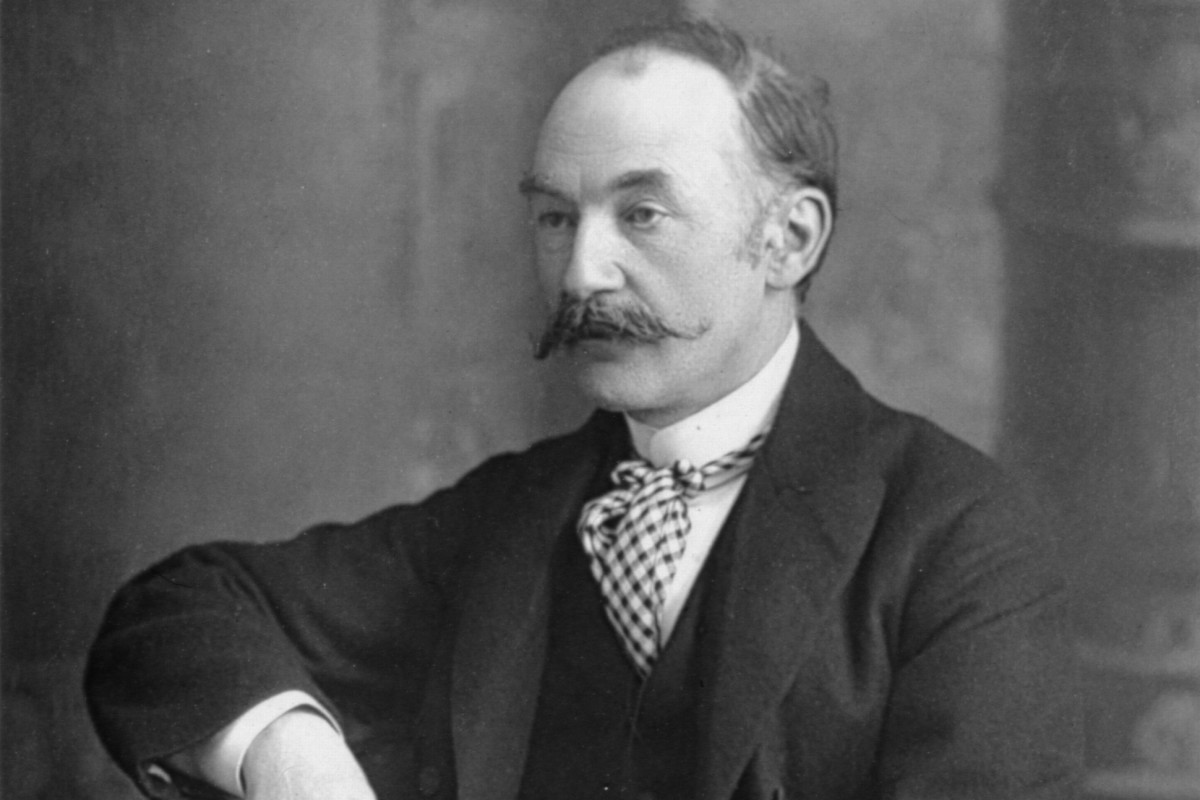Thomas Hardy, the son of a stonemason, was born in Dorset, England, on June 2, 1840. He trained as an architect and worked in London and Dorset for ten years. Hardy began his writing career as a novelist, publishing Desperate Remedies (Tinsley Brothers) in 1871, and was soon successful enough to leave the field of architecture for writing.
Analysis of ‘The Workbook’ by Thomas Hardy
In Thomas Hardy’s “The Workbox” the readers come across the husband who is a carpenter, his wife, the deceased John Wayward, and the narrator. The opening lines begin with the husband presenting his wife with a gift made of his own hand, a sewing box “[t]hat [he] made of polished oak”. The wife seems genuinely pleased with his offering, smiling and saying, “Twill last all my sewing years!”. As the story continues, the husband tells his wife about the origin of the wood that is the wood was a remnant of John Wayward’s coffin.
As the husband tells his story, he notices he notices a sudden change in his wife and she has become somewhat upset. At first, the husband thinks that his wife may have known the deceased, which she denies, noting that John Wayward must have been older than she, leaving their village before she was grown. The husband then comes to the conclusion that his wife is upset due to the fact her sewing box came from the same piece of wood John Wayward’s coffin was constructed of which again the wife denies, but her expression and body language seem to tell something different. At this point, it becomes evident the wife probably knows much more about John Wayward than she is prepared to admit to her husband.
It now becomes evident to the readers that the carpenter‘s wife knows more than she was willing to discuss with her husband. Hardy leaves several hints to spark the readers’ imagination throughout the poem. In the final stanza, Hardy writes,
“Yet her lips were limp and wan,
Her face still held aside,
As if, she had known not only John,
But known of what he died”.
The final stanza suggests that the wife knew John Wayward. The use of his given name only, in line thirty-nine, the description of the wife‘s features, and her reaction to the news of John Wayward’s death suggest that she and Wayward were not only from the same hometown, but had known one another, perhaps intimately. In the fourth stanza, Hardy is showing a possible connection between the two that carries even to the grave:
“The shingled pattern that seems to cease
Against your box’s rim
Continues right on the piece
That’s underground with him”.
Despite all the attempts of the carpenter’s wife to not express it seems very evident that she had some sort of a relationship with John Wayward, which for some reason he has not shared with his husband. Maybe she did not find any need to or she just did not want to, is something still in vague but by giving her the box, the husband has unintentionally brought up a very important part of his wife’s life which she never wanted to share.
The most important element, which comes up upon analyzing the poem, is the poet’s playing with the emotions which lies between a husband and his wife. It is obviously all right to have any sort of relationship before a marriage but if that very thing somehow comes back into the life after a marriage it may turn out be disastrous. Thomas Hardy in his poem dealt with certain emotional aspects of a young couple who finds themselves suddenly with a third person in their life even though that person is deceased. Still, he will forever have a place in the heart of the wife and in the mind of the husband.
The Workbook by Thomas Hardy Theme
The main theme that one can draw out from this poem is the theme of hidden guilt, which has been high lightened through the character of the wife. However, this whole scenario might just have arrived from the experiences of the poet himself that is his doomed love affair with his cousin Tryphena Sparks.
While staying at his home in the summer of 1867 Hardy met Tryphena Sparks, the sixteen-year-old daughter of a family related to his own. Trevor Johnson goes says, “Theirs was a passionate, tempestuous, and one suspects a precarious relationship. At all events, Tryphena returned Hardy’s engagement ring in 1872, after five years–an agonizing blow for him”. This goes to show that Hardy had much sorrow and heartache in his life, and it had a definite impact on his writing. Johnson states, “Her influence on his work is incalculable”. Terry Coleman further reinforces this statement by writing, “I believe she was one of the principal influences on his work”.
Indeed this whole situation, which Hardy has portrayed in his poem where we see a sudden arrival of a third person even though very much dead into the life of a lovely young couple very much signifies his own and this very element adds an extra layer of brilliance in this poem.
The Workbook by Thomas Hardy Tone
In this poem written by Thomas Hardy, we can almost predict what the meaning and the tone will be like. Not unlike his other famous poems, Hardy used fatalistic phrases that portrayed his attitude towards death and mortality. He rejected the Victorian belief in a benevolent God, and much of his poetry is viewed as an outcry for the misery of the human condition and their final fate, death. Hardy starts the poem with a very patronizing attitude towards women, writing “See, here´s the workbox, little wife”; this is probably the view of women when the poem was written. This is Hardy´s way of introducing the characters, stating that the husband and wife are completely different, not only in their backgrounds but also in their attitudes towards death. This is one of the only bits of the poem that is written as a narrative instead of dialogue.
In the second stanza, Hardy starts the actual story of the poem. The poet comes up with the gift to his wife and she answers him smiling, “Twill lasts all my sewing years”. Hardy here mostly in the wants to emphasize that his wife is a little anxious, and the way she is saying it, is typical of someone when they´re in denial.
Dramatic irony plays a very important part in molding the tone and theme of the poem. In that, very sense the husband himself can be compared with Oedipus who literally brought his own destruction upon him. Knowingly or unknowingly, the husband gifted his wife the box, which came from the same tree as the coin of wife’s lover – John Wayward. This sense of dramatic irony is relevant throughout the poem that without having the knowledge the husband did something, which had a much implication or will have a much bigger effect in their married life.
Reading the poem one understands things never thought about before. According to a certain reader: the wife of the main character came from a different town, where she loved John Wayward. Her husband killed John because of rage, anger, and jealousy. Then he made a wooden box as a gift for her, thus, this box reminded her about the great love for John Wayward that did not die, but always will exist. The ending of the story tells it clearly. Another one can understand in the other direction: the wife was in love with John Wayward; she waited, but then moved to the city, where she married a new person. Next John Wayward dies and her husband presents her a box of the same material of the grave. Thus, the ending reminds that the wooden box will always make sure that she never forgets her past. The situations are not said through the poem, so that the reader may imagine and understand as he or she wants.
Conclusion
No one can deny the sheer brilliance of Thomas Hardy and after coming across this poem, it can be seen the way he depicts emotions which changes from joy to agony to a sense of hidden guilt in the part of the wife. This is a poem, which is open to various interpretations, and it is up to the reader to imagine it in their own vision. However, in my view not only it stands out as a literal masterpiece but also an effective read for both the set of people, who have been in such a situation and who have not. Since I guess this is where lies the brilliance of the poet as this is a poem, which we can understand without having prior information about the author’s background as it carries a message of its own, which may vary from reader to reader.
Some online learning platforms provide certifications, while others are designed to simply grow your skills in your personal and professional life. Including Masterclass and Coursera, here are our recommendations for the best online learning platforms you can sign up for today.
The 7 Best Online Learning Platforms of 2022
- Best Overall: Coursera
- Best for Niche Topics: Udemy
- Best for Creative Fields: Skillshare
- Best for Celebrity Lessons: MasterClass
- Best for STEM: EdX
- Best for Career Building: Udacity
- Best for Data Learning: Pluralsight







